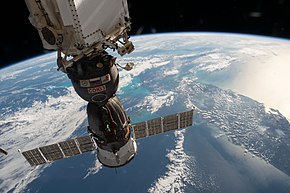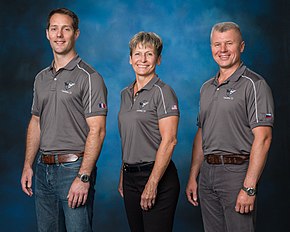Soyuz MS-03
 Soyuz MS-03 docked to International Space Station (ISS). | |
| Mission type | ISS crew transport |
|---|---|
| Operator | Roskosmos |
| COSPAR ID | 2016-070A |
| SATCAT no. | 41864 |
| Mission duration | 196 days 17 hours 49 minutes |
| Spacecraft properties | |
| Spacecraft | Soyuz MS |
| Spacecraft type | Soyuz MS 11F732A48 |
| Manufacturer | RKK Energia |
| Launch mass | 7080 kg |
| Crew | |
| Crew size | 3 (launching) 2 (landing) |
| Members | Oleg Novitsky Thomas Pesquet |
| Launching | Peggy Whitson |
| Callsign | Kazbek |
| Start of mission | |
| Launch date | 17 November 2016, 20:17:00 UTC |
| Rocket | Soyuz-FG |
| Launch site | Baikonur, Site 1 |
| Contractor | Progress Rocket Space Centre |
| End of mission | |
| Landing date | 2 June 2017, 14:10 UTC |
| Landing site | Steppes of the Kazakhstan |
| Orbital parameters | |
| Reference system | Geocentric orbit |
| Regime | Low Earth orbit |
| Inclination | 51.66° |
| Docking with ISS | |
| Docking port | Rassvet nadir |
| Docking date | 19 November 2016, 21:58 UTC |
| Undocking date | 2 June 2017, 10:47 UTC |
| Time docked | 194 days |
 Soyuz MS-03 mission patch  (l-r) Pesquet, Whitson and Novitsky Soyuz programme (Crewed missions) | |
Soyuz MS-03 was a Soyuz spaceflight launched on 17 November 2016.[1] It transported three members of the Expedition 50 crew to the International Space Station. MS-03 was the 132nd flight of a Soyuz spacecraft. The crew consisted of a Russian commander with American and French flight engineers.[2]
Crew[]
| Position[3] | Launching Crew Member | Landing Crew Member |
|---|---|---|
| Commander | Expedition 50 Second spaceflight | |
| Flight Engineer 1 | Expedition 50 First spaceflight | |
| Flight Engineer 2 | Expedition 50 Third[5] spaceflight |
N/A [4] |
Backup crew[]
| Position[6] | Crew Member | |
|---|---|---|
| Commander | ||
| Flight Engineer 1 | ||
| Flight Engineer 2 | ||
Mission highlights[]
Soyuz MS-03 launched with Expedition 50/51 on 17 November 2016, at 20:17 UTC. Astronaut Peggy Whitson, at age 56, became the oldest woman to fly into space.[7][8] Soyuz MS-03 docked at the International Space Station on 19 November 2016.[9] On 2 June 2017, Soyuz MS-03 undocked from the ISS, carrying Oleg Novitsky and Thomas Pesquet back to Earth after 196 days in space. Whitson remained on the ISS and returned on Soyuz MS-04 on 3 September 2017.
References[]
- ^ "Soyuz MS-03 mission".
- ^ "Display: Soyuz MS-03 2016-070A". NASA. 14 May 2020. Retrieved 27 November 2020.
 This article incorporates text from this source, which is in the public domain.
This article incorporates text from this source, which is in the public domain.
- ^ Планируемые полёты. astronaut.ru (in Russian). Retrieved 13 March 2014.
- ^ Harwood, William. "Whitson's station expedition extended three months". Spaceflight Now. Retrieved 5 April 2017.
- ^ Potter, Sean (15 June 2018). "Record-Setting NASA Astronaut Peggy Whitson Retires". NASA. Retrieved 24 June 2018.
 This article incorporates text from this source, which is in the public domain.
This article incorporates text from this source, which is in the public domain.
- ^ astronaut.ru (2015). "Планируемые полёты" (in Russian).
- ^ "NASA's Peggy Whitson Becomes Oldest Woman in Space". abcnews.go.com. ABC News. Retrieved 19 November 2016.
- ^ Chiara Palazzo (18 November 2016). "NASA veteran Peggy Whitson becomes the oldest woman in space as she blasts off for ISS". The Telegraph. Telegraph.co.uk. Retrieved 19 November 2016.
- ^ "Welcome Aboard! New Arrivals Make Six Expedition 50 Crew Members | Space Station". blogs.nasa.gov. Retrieved 24 November 2016.
 This article incorporates text from this source, which is in the public domain.
This article incorporates text from this source, which is in the public domain.
- Crewed Soyuz missions
- Spacecraft launched in 2016
- 2016 in Russia
- Spacecraft which reentered in 2017
- Spacecraft launched by Soyuz-FG rockets
- Fully civilian crewed orbital spaceflights


